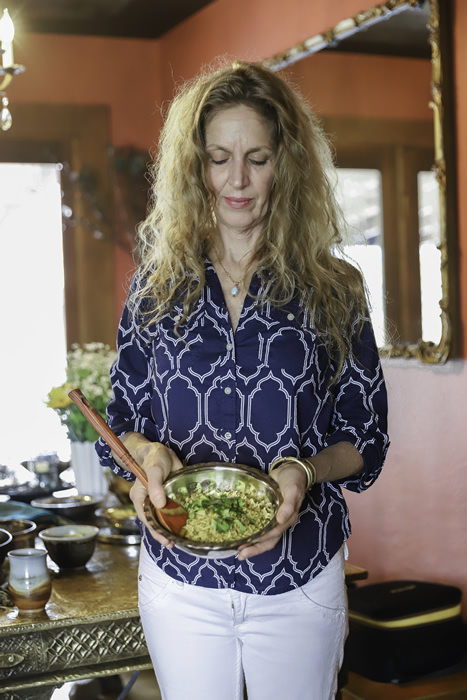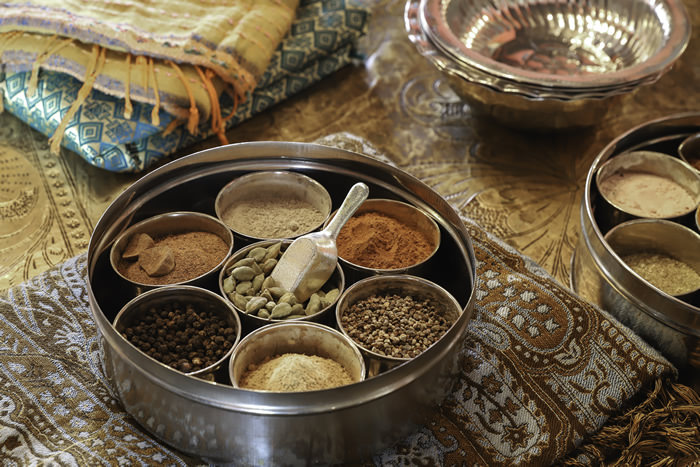feature
WALKING THE AYURVEDIC PATH
An age-old system of eating reportedly leads to good health and all-around balance.
WRITTEN BY NATASHA BOURLIN
PHOTOS BY SHAUN HUNTER
Spices used frequently in ayurvedic dishes include cardamom pods (center) as well as
(from top, clockwise) nutmeg, cinnamon, cardamom seeds, ginger, black peppercorns, and cardamom powder
“When diet is wrong, medicine is of no use. When diet is correct, medicine is of no need.”– Ayurvedic Proverb
Feeling sluggish, ill, or just not quite right, but not sure why? If you’ve tried supplements, medications, and more, maybe it’s time to explore ayurveda.
Thousands of years ago in India, this holistic, medicinal system of eating was developed — one that’s still practiced globally today, essentially in its original form. Literally translated, ayurveda means the science of life. In the millennia-old philosophy, achieving physical, mental, and spiritual balance is essential to a healthy, fulfilling existence. Balance is attained largely through what we ingest and how.
Ayurvedic eating is healing and preventative by nature, based on an understanding of how certain foods affect our bodies. It’s a nutritional journey that can be embarked upon at any time. When outlined dietary guidelines are followed after a thorough consultation, ayurveda practitioners regularly see life-changing results in clients. The first step is determining which of the three constitutions, or doshas, they have.
Doshas — vata, pitta, and kapha — on a surface level may be correlated with the body types modern medicine defines as endomorph (high in body fat, pear shaped), ectomorph (lean and long), and mesomorph (muscular, with high metabolism). Each has predominant physical characteristics, though some crossover exists in everyone. Typecasting doshas in the philosophy of ayurveda involves looking more deeply than the physical, though.
What should be ingested to attain optimal overall health can be determined after dosha identification. Professional practitioners delve more deeply into this, but a good first step is to take a dosha quiz, such as those on Doshaguru.com or Chopra.com.
“Ayurveda attempts to bring harmony in biological humors (doshas) in the body,” says Rajan Zed, president of the Universal Society of Hinduism in Reno. “Eating changes with the seasons as constitutions balance or imbalance with seasons. At the heart of ayurvedic eating is proper digestion.”

Laura Hennings, Reno ayurvedic practitioner and chef, with a bowl of kitchari
You are what you digest
Dr. Suhas Kshirsagar, acclaimed director of the Ayurvedic Healing and Integrative Wellness Clinic in Santa Cruz, Calif., advises that for proper digestion and metabolism of foods, it’s best to eat a plant-based diet, full of all-natural, clean foods abundant in colors and textures and filled with life energy, known as prana, not preservatives and additives.
In ayurveda, it’s understood that every living thing is made up of five elements, which can become unbalanced: air, fire, water, earth, and ether. Six tastes and their associated foods and spices — sour, salty, sweet, bitter, pungent, and astringent — serve to right the imbalances and positively affect health on every level.
Cells in the human body are naturally tuned to use nutrition provided by fresh, seasonal, organic sustenance. Canned, frozen, processed, and even leftover foods are not recommended in ayurveda. Certain spices and pure oils such as ghee are vital.
In a society set on instant gratification and quick fixes, ayurveda teaches the opposite. Americans tend to try and make remedies work around their lifestyles, rather than make their lifestyles conducive to good overall health. There’s a pill for everything these days, but ayurvedic healing stems from diet, not pharmaceuticals.
“About 80 percent of all chronic diseases can be cured by diet alone,” says Radheka Patel Savoy, an ayurvedic health and wellness counselor in Reno. “Ayurveda is about getting to the root of the problem; you want to find out why you’re manifesting these symptoms and address the causative factors first. Temporary fixes don’t work; you need to get to the root of what’s causing it.”
Prana as sustenance
Practitioners say that when a person properly follows an individualized ayurvedic eating plan, he or she experiences mental and emotional clarity, improved overall well-being and awareness, more motivation, and a stronger immune system. These individuals sleep, move, and feel better, and often can wean off medications.
“Symptoms aren’t happening to you, they’re happening for you,” says ayurveda practitioner and chef Laura Hennings of Reno. “I start out by determining the person’s dosha, then what that person’s balance is, and from there, it’s all about diet. Balance the imbalance; it’s that simple. But if you don’t change diet, nothing matters.”
As an example, Hennings says she’s had clients come to her wondering why they had heartburn or couldn’t sleep, when they had poured coffee — a caffeinated acid — into their livers and kidneys first thing in the morning, then wine — another acid — at the end of the day.
Eating fresh, organic items as close to their sources as possible is key. Savoy provides an illustrative example. You can plant a seed from a vegetable and get a new vegetable plant. These are the foods you want to eat, predominantly. The same cycle doesn’t apply to meat. Unfortunately, you can’t plant a steak and get another cow.
Hitting the reset button
In ayurveda, spring and fall are the best times to cleanse and start anew, when Mother Nature hits the reset button and our bodies are naturally inclined to follow suit. In spring, bodies release toxins known as ama that accumulate during colder months when richer, oil-heavy foods are consumed. Fall is time to prepare our bodies for the seasonal transition and intake of heavier foods.
Hennings suggests beginning the ayurvedic journey with a three-day cleanse eating only a traditional dish, kitchari, along with water or ayurvedic tea. She gets many of her ingredients locally at KJ Mini Mart, a family-owned Indian market; just make sure they’re organic.
Cooking at home is preferred, though you may discover the occasional restaurant that practices ayurveda. Chef-owner Anitha Chiranjivi of Maya’s South Indian Cuisine at the West Street Market in Reno serves organic, vegan dishes made with recipes passed down in her family for generations, all of which adhere to ayurvedic principles.
“All Indian cooking is medicinal by nature,” Chiranjivi says.
New science can make ayurvedic beliefs practiced for millennia seem innovative. For instance, turmeric and cumin, foundational ayurvedic spices, have only recently been touted in America for their anti-inflammatory and digestive properties.
Dr. Kshirsagar calls it a case of “new sciences validating age-old wisdom.”
Or, as the adage goes, everything old is new again.
Resources
Ayurvedic teas
Photo courtesy of Davidson’s Organics
When Kunall Patel and Promilla Mohan, co-owners of Davidson’s Organics in Reno, sought an ayurveda expert to help them formulate traditional blends for their Ayurvedic Infusions tea line, they serendipitously stumbled upon Drs. Suhas Kshirsagar and Manisha Kshirsagar of the Ayurvedic Healing and Integrative Wellness Clinic in Santa Cruz, who were looking for a tea expert to create portable ayurvedic mixtures.
“It was important to all of us — [the Kshirsagars], my business partner Promilla, and myself — to introduce Western culture to ayurveda, and to provide those benefits and that knowledge in a form that could easily be incorporated into their everyday lifestyles,” Patel says.
The new Davidson’s line offers seven ayurvedic teas: Sleep, Slim, Digest, Laxative, Detox, and Decongest. Each features aromatically appealing, distinctive flavors and feels exotically healthy when sipped. They’re available at Whole Foods Market, Scolari’s, and the Great Basin Community Food Co-op in Reno, and online at Davidsonstea.com.
Recipes
Golden Turmeric Milk
(courtesy of Laura Hennings, ayurveda practitioner and chef in Reno. Serves 2)
7 almonds, soaked in water overnight
3 Medjool dates
¼ teaspoon turmeric
⅛ teaspoon cinnamon
⅛ teaspoon ginger
⅛ teaspoon cardamom
⅛ teaspoon nutmeg
2 cups boiling water
Combine ingredients in Vitamix or blender and blend until smooth.
Kitchari
(courtesy of Laura Hennings, ayurveda practitioner and chef in Reno. Serves 4)

¾ cup white basmati rice
¼ cup split mung dal
1¾ cups water
1 teaspoon ginger, freshly grated
Combine ingredients, then bring to boil in covered pot. Boil 5 minutes. Turn to low and simmer 20 minutes.
Combine in iron skillet over medium heat:
2 tablespoons ghee
1 teaspoon turmeric
1 teaspoon coriander powder
1 teaspoon cumin powder
1 teaspoon black mustard seed
Heat until black mustard seed pops. Reduce heat and add rice and mung dal. Coat all the rice and dal with ghee and spices. Add chopped cilantro to garnish.
Ghee
(courtesy of Radheka Patel Savoy, ayurvedic health and wellness counselor in Reno. Makes 16 ounces)
Put 1 pound organic unsalted butter into pot and heat on medium for about 15 to 20 minutes. Butter will melt in the beginning, forming a thick, cloudy, liquid form. Slowly, cloudiness will lessen, and liquid will become transparent. You will also hear a hissing sound. In a few minutes, you will see the transparent ghee on the top and the golden brown sediment at the bottom. Now it is ready.
Remove pot from heat. Let cool for few minutes, then strain into thick glass jar through a stainless steel strainer or cheesecloth. Store ghee at room temperature. Never refrigerate.
Ayurvedic Vegetable Soup
(courtesy of Radheka Patel Savoy, ayurvedic health and wellness counselor in Reno. Serves 6 to 7)
The unique blend of herbs and vegetables makes this soup balancing to all three doshas, or mind-body types (vata, pitta, and kapha).
1 large onion
½ head cabbage
1 medium carrot
2 stalks celery
1 tablespoon olive oil
5 cups water
1 teaspoon ginger, minced
1½ teaspoons coriander powder
½ teaspoon cumin powder
½ teaspoon turmeric powder
½ teaspoon cayenne powder
1 teaspoon salt (or to taste)
1 tablespoon lemon juice
Wash onion, cabbage, carrot, and celery, and cut all into 1-centimeter pieces. Heat oil in big pot. Add onion, and sauté 3 minutes. Add other vegetables, and sauté 2 minutes. Add 2 cups water, ginger, turmeric, and salt, and cook 10 minutes. Add coriander, cumin, and cayenne powder, then cook 15 more minutes. Add 3 cups water and cook 5 more minutes. Before serving, add lemon juice and mix well. Serve hot.


